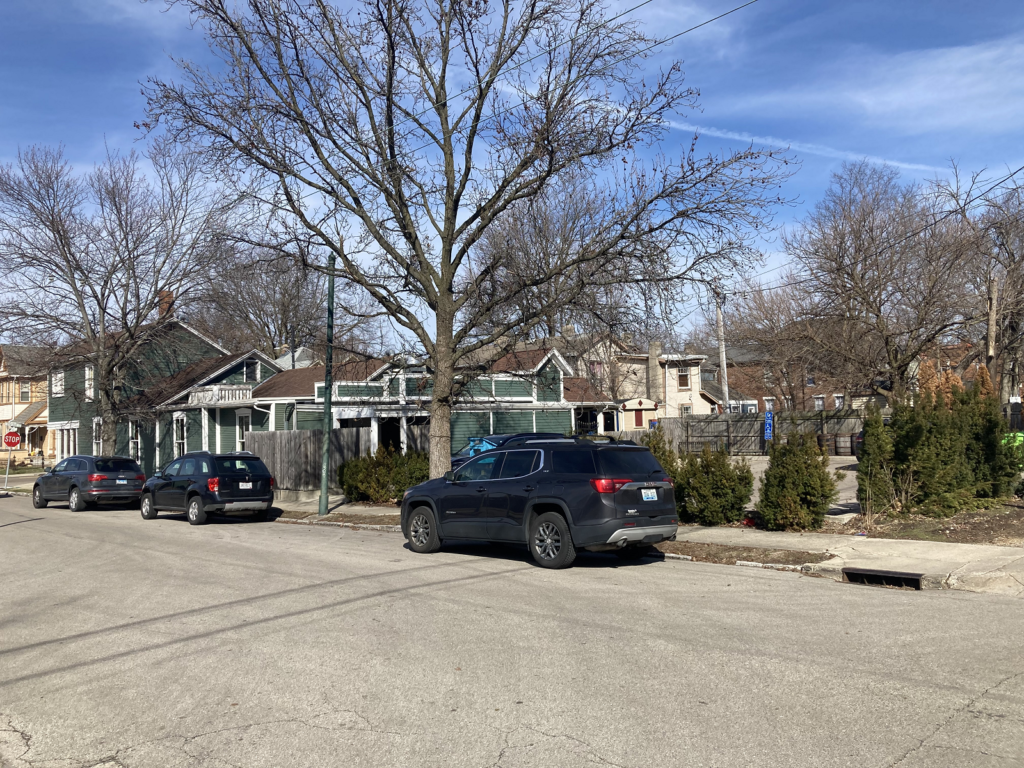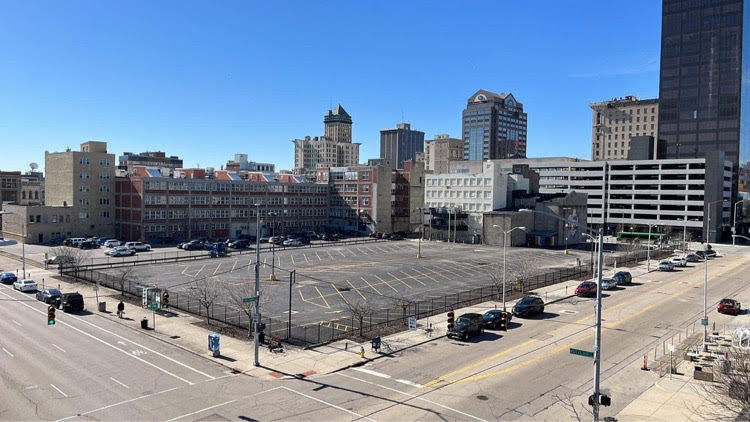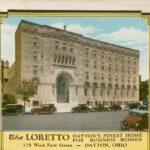Editor’s Note: This is a guest article written by Matt Sauer
In 1923, the city of Columbus required a new apartment building to provide off street parking, the first time parking minimums (as they would come to be called) were ever enforced in the US.
City governments were just beginning to address the growing need for parking in places that had been built around walking, streetcars, and the horse and buggy.
Prior to this, when a developer built a garage or parking space on the same parcel as a building they did so voluntarily. Zoning codes were still new and not yet focused on the automobile. But growing car ownership and the desire to park vehicles close to homes and businesses put pressure on public space.
Look around Dayton and you can see the early impact of trips by car into downtown. Buildings like the Ohmer Garage on East First Street or the First Street Garage at 21 W. First (both constructed in the 1920s) were built to store cars while their owners worked or shopped. Surface parking lots replaced notable buildings like the Loretto and Dayton’s Union Station.
But parking was not so quickly corralled by private parking and in many cities it overwhelmed street curbs, public squares, and plazas. So cities like Columbus responded with what are now called parking minimums.
Public space in cities is not infinite and shouldn’t be given away for free. Why should developers benefit from free parking on the street? Without parking the businesses or residences they create might not be able to exist and the taxpayer is subsidizing a critical part of the development.
Cities attempted to solve the freeloader problem and alleviate pressure on the public street with parking minimums, making the developer build parking spaces for the vehicle traffic that they create.
Exactly how cities do this is usually through a parking ratio, a certain number of parking spaces for a given amount of building.
A zoning code might require a clothing store to provide 3 parking spaces for every 1,000 square feet of space. So a 2,000 square foot shop would need 6 parking spaces.
The owner can’t count the parking spaces on the curb out front or the parking garage down the street or even a bus stop a few doors away; off-street parking must share the same piece of land as the building. People arriving by foot, bike, or bus are implicitly factored into the parking ratio.
Zoning codes make an attempt to tailor parking minimums to the type of use or business, but in practice there’s often not much distinction. Worse, the urban context is also treated with a broad brush.
Old Scratch Pizza on wide, heavily trafficked Patterson Boulevard is going to derive more traffic from cars (and need more parking) than Fifth Street Brewpub, which is in a tight-knit neighborhood and can count on at least some patrons arriving by foot or bicycle. They may nevertheless have similar parking requirements in the zoning code.

Parking minimums essentially act as a tax on development. While most buildings in the US need some amount of parking for a development to work, mandated minimums effectively obligate the developer to provide more parking than they might need or to go through a time-wasting variance process to appeal a lower amount of parking than the zoning code requires.
When you consider that parking spaces can cost around $3,000 for a surface lot or tens of thousands for a multi-level garage, it’s clear that the overall cost of construction and need for capital becomes greater.
Then there’s the issue of whether parking is a good use of land. How often do we see nearly empty parking lots, not just after hours, but while businesses are open? Some estimates claim there are 8 parking spaces for every vehicle in the US.

Not all of this is driven (sorry!) by parking minimums, but they set a floor that can cause developers to provide more parking than is perhaps needed, whether to placate neighbors or lending institutions.
Fundamentally, land is scarce and parking crowds out more active uses: places to live and work. No one visits parking lots.
Until I started researching this article I wasn’t aware that 2023 was the 100th anniversary of parking minimums. No one has baked a cake.
Instead, cities around the country, led by Buffalo, New York, are eliminating parking minimums or even implementing parking maximums, capping the total amount of parking that can be provided.
Dayton should follow their lead and remove parking minimums from our zoning code. We should make our city less car dependent, safer and easier to walk and bike in, and expand convenient and frequent bus and trolley service.
When we require parking by law, we perpetuate the need for cars, burdening families with the cost of car ownership, making apartments, homes, and offices more expensive, and the places we want to go become more spread out.
Removing parking minimums won’t make existing parking go away. Developers will still be able to provide the amount of parking that makes sense for new developments.
But it gives everyone the flexibility to build more sustainably and creatively. What could all the space we used to give over to parking become instead? Playgrounds? Workshops? Tiny homes? Corner stores? Let’s find out.
About the author: Matt Sauer is an architect living and working in Dayton. He’s written about the benefits of removing US35 from downtown and about growing Dayton’s population. Matt is a volunteer member of the City’s Plan Board. #dayton260k




We have so much parking downtown. We really need to get rid of all street parking. There are plenty of lots and garages. This would make the construction of protected bike lanes so easy.